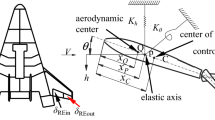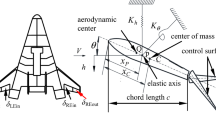Abstract
In current study for wing flutter of reentry vehicle, the effect of input saturation to wing flutter is rarely considered and few of the fault-tolerant control problem is taken into account. In this paper, we use the radial basis function neural network and the finite-time adaptive fault-tolerant control technique to deal with the wing flutter problem, which is subject to input saturation, parameter uncertainties and external disturbances. Sensor and actuator faults are both considered in the control design. Firstly, an optimal flight trajectory of reentry vehicle is designed using the conjugate gradient method, so as to decrease the aerodynamic heating rate and temperature on the surface of the reentry vehicle. Then based on the trajectory optimization, we ignore the effect of temperature, and build up the motion equation of wing flutter. Finally, a finite-time H ∞ adaptive fault-tolerant controller is introduced. Simulation results indicate that, the optimized trajectory designed may decrease the aerodynamic heating rate of the reentry vehicle; the designed fault-tolerant controller can effectively deal with the faults in the system and can promptly suppress the wing flutter as well.
Similar content being viewed by others
References
A. E. Thomas, “Fluid/chemistry modeling for hypersonic flight analysis,” Computers Math Applications, vol. 24, no. 5/6, pp. 25–36, September 1992. [click]
A. Mazzaracchio and M. Marchetti, “Aprobabilistic sizing tool and monte carlo analysis for entry vehicle ablative thermal protection systems,” Acta Astronautica, vol. 66, no. 5/6, pp. 821–835, March 2010. [click]
Y. H. Zhao, “Flutter suppression of a high aspect-ratio wing with multiple control surfaces,” Journal of Sound and Vibration, vol. 324, no. 3, pp. 490–513, July 2009.
Z. Wang, A. Behal, and P. Marzocca, “Model-free control design for multi-input multi-output aerolastic system subject to external disturbance,” Journal of Guidance, Control, and Dynamics, vol. 34, no. 2, pp. 446–458, March-April 2011. [click]
Z. Wang, A. Behal, and P. Marzocca, “Continuous robust control for two-dimensional airfoils with leading and trailing-edge flaps,” Journal of Guidance, Control, and Dynamics, vol. 35, no. 2, pp. 510–519, March-April 2012. [click]
K. Zhang, Z. Wang, A. Behal, and P. Marzocca, “Novel nonlinear control design for a two-dimensional airfoil under unsteady flow,” Journal of Guidance, Control, and Dynamics, vol. 36, no. 6, pp. 1681–1694, November-December 2013. [click]
M. Cassaro and M. Battipede, “Comparison of adaptive control architectures for flutter suppression,” Journal of Guidance, Control, and Dynamics, vol. 38, no. 2, pp. 346–354, February 2015.
X. J. Li and G. H. Yang, “Robust adaptive fault-tolerant control for uncertain linear systems with actuator failures,” IET Control Theory and Applications, vol. 6, no. 10, pp. 1544–1551, February 2012.
M. Blanke, R. Izadi-Zamanabadi, and S. A. Bosh, “Faulttolerant control systems-A holistic view,” Control Engineering Practice, vol. 5, no. 5, pp. 693–702, May 1997. [click]
A. Zolghadri, “Advanced model-based FDIR techniques for aerospace systems: Today challenges and opportunities,” Progress in Aerospace Sciences, vol. 53, pp. 18–29, August 2012. [click]
Q. Shen, D. W. Wang, and S. Q. Zhu, “Integral-type sliding mode fault-tolerant control for attitude stabilization of spacecraft,” IEEE Transactions on Control Systems Technology, vol. 23, no. 3, pp. 1041–1051, May 2015.
Q. Shen, D. W. Wang, S. Q. Zhu, and E. K. Poh, “Inertiafree fault-tolerant spacecraft attitude tracking using control allocation,” Automatica, vol. 62, pp. 114–121, December 2015. [click]
B. Xu, Y. Y. Guo, Y. Yuan, Y. H. Fan, and D. W. Wang, “Fault-tolerant control using command-filtered adaptive back-stepping technique: application to hypersonic longitudinal flight dynamics,” International Journal of Adaptive Control and Signal Processing, vol. 30, pp. 553–577, August 2016.
C. S. Liu, B. Jiang, and S. J. Zhang, “Fault-tolerant synthesis controller design for a flight-tracking system,” IET Control Theory and Applications, vol. 5, no. 11, pp. 1243–1254, July 2011.
L. I. Allerhand and U. Shaked, “Robust switching-based fault tolerant control,” IEEE Transactions on Automatic Control, vol. 60, no. 8, pp. 2272–2276, August 2015.
Q. X. Jia, W. Chen, Y. C. Zhang, and H. Y. Li, “Fault reconstruction and fault-tolerant control via learning observers in Takagi-Sugeno fuzzy descriptor systems with time delays,” IEEE Transactions on Industrial Electronics, vol. 62, no. 6, pp. 114–121, June 2015.
B. Xu, X. Y. Huang, D.W. Wang, and F. C. Sun, “Dynamic surface control of constrained hypersonic flight models with parameter estimation and actuator compensation,” Asian Journal of Control, vol. 16, no. 1, pp. 162–174, January 2014.
B. Xu, Z. K. Shi, and C. G. Yang, “Composite fuzzy control of a class of uncertain nonlinear systems with disturbance observer,” Nonlinear Dynamics, vol. 80, no. 1–2, pp. 341–351, April 2015. [click]
Y. Zhong, “Globally stable adaptive system design for minimum phase SISO plants with input saturation,” Automatica, vol. 41, no. 9, pp. 1539–1547, September 2005. [click]
N. D. S. Sarah and S. K. Nesrin, “Survey of planetary entry guidance algorithms,” Progress in Aerospace Sciences, vol. 68, pp. 64–74, July 2014. [click]
R. Jamilnia and A. Naghash, “Simultaneous optimization of staging and trajectory of launch vehicles using two different approaches,” Aerospace Science and Technology, vol. 23, no. 1, pp. 85–92, December 2012. [click]
B. L. Tian, Q. Zong, and J. Wang, “Quasi-continuous highorder sliding mode controller design for reusable launch vehicles in reentry phase,” Aerospace Science and Technology, vol. 28, no. 1, pp. 198–207, July 2013. [click]
D. Dirkx and E. Mooij, “Optimization of entry-vehicle shapes during conceptual design,” Acta Astronautica, vol. 94, no. 1, pp. 198–214, January 2014. [click]
L. Q. Zhou, Y. S. Chen, and F. Q. Chen, “Chaotic motions of a two-dimensional airfoil with cubic nonlinearity in supersonic flow,” Aerospace Science and Technology, vol. 25, no. 1, pp. 138–144, March 2013. [click]
Y. M. Chen, J. K. Liu, and G. Meng, “Equivalent damping of aeroelastic system of an wing with cubic stiffness,” Journal of Fluids and Structures, vol. 27, no. 8, pp. 1447–1454, November 2011.
J. N. Lu, H. P. Hu, and Y. P. Bai, “Generalized radial basis function neural network based on an improved dynamic particle swarm optimization and AdaBoost algorithm,” Neurocomputing, vol. 152, no. 25, pp. 305–315, March 2015. [click]
F. Amato and M. Ariola, “Finite-time control of linear systems subject to parametric uncertainties and disturbances,” Automatica, vol. 37, no. 9, pp. 1459–1463, September 2001.
Q. Y. Meng and Y. J. Shen, “Finite-time H ∞ control for linear continuous system with norm-bounded disturbance,” Communications in Nonlinear Science and Numerical Simulation, vol. 14, no. 4, pp. 1043–1049, April 2009. [click]
W. Zhang, H. S. Su, and H. W. Wang, “Full-order and reduced-order observers for one-sided Lipschitz nonlinear systems using Riccati equations,” Communications in Nonlinear Science and Numerical Simulation, vol. 17, no. 12, pp. 4968–4977, December 2012. [click]
Author information
Authors and Affiliations
Corresponding author
Additional information
Recommended by Associate Editor Sing Kiong Nguang under the direction of Editor Fuchun Sun. This work is supported by the Natural Science Foundation of China (11272202, 11132001 and 11472171), the Key Scientific Project of Shanghai Municipal Education Commission (14ZZ021), the Natural Science Foundation of Shanghai (14ZR1421000) and the Special Fund for Talent Development of Minhang District of Shanghai.
Ming-Zhou Gao is a Ph.D. candidate of Shanghai Jiaotong University, China. His major in Engineering Mechanics. His current research interests focus on structural dynamics and control.
Guo-Ping Cai is a professor in the Department of Engineering Mechanics, Shanghai Jiaotong University, China. He received the Ph.D. degree in Engineering Mechanics from Xi’an Jiaotong University in 2000. His current research interests focus on structural dynamics and control, delayed system dynamics and control, and coupled system dynamics and control.
Rights and permissions
About this article
Cite this article
Gao, MZ., Cai, GP. Finite-time H ∞ adaptive fault-tolerant control for wing flutter of reentry vehicle subject to input saturation. Int. J. Control Autom. Syst. 15, 362–374 (2017). https://doi.org/10.1007/s12555-015-0311-9
Received:
Revised:
Accepted:
Published:
Issue Date:
DOI: https://doi.org/10.1007/s12555-015-0311-9




